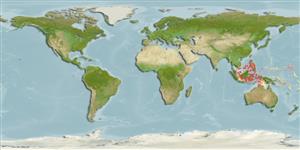>
Gobiiformes (Gobies) >
Gobiidae (Gobies) > Gobiinae
Etymology: Trimma: Greek, trimma, -atos = something crushed (Ref. 45335); corerefum: Name from the arbitrary combination of letters reflecting the Coral Reef ResearchFoundation in Palau and is pronounced 'core-ref-um'; an organization, established and operated by Pat and Lori Colin; noun in apposition..
Environment: milieu / climate zone / depth range / distribution range
Sinh thái học
Biển; Mức độ sâu 10 - 30 m (Ref. 109919), usually 12 - 30 m (Ref. 109919). Tropical
Sự phân bố
Các nước | Các khu vực của FAO | Các hệ sinh thái | Những lần xuất hiện | Point map | Những chỉ dẫn | Faunafri
Western Pacific: Palau, Indonesia and the Philippines.
Bộ gần gũi / Khối lượng (Trọng lượng) / Age
Maturity: Lm ? range ? - ? cm
Max length : 1.7 cm SL con đực/không giới tính; (Ref. 109919); 1.9 cm SL (female)
Short description
Hình thái học | Sinh trắc học
Các tia vây lưng cứng (tổng cộng): 7; Các vây lưng mềm (tổng cộng): 8; Tia cứng vây hậu môn 1; Tia mềm vây hậu môn: 8. This species is distinguished by the following characters: possess a bony interorbital about three-quarters pupil diameter (68-85%), with a fully scaled nape, the anterior rows cycloid in adults, a second dorsal spine that usually reaches middle of the second dorsal fin; two cephalic sensory papillae in row f on the chin and in row r on the top of the snout, 2-5 (usually 4) papillae in row d? immediately behind the maxilla, usually 13 (range = 12-14) unbranched pectoral-fin rays, and an unbranched fifth pelvic-fin ray that is 34-45% the length of the fourth ray. Colour of freshly collected specimens: reddish head and anterior nape except below a line bounded by the horizontal limb of preopercle, where these are white; red opercular region and abdomen with a liberal sprinkling of large, dark brown melanophores, a pupil-diameter wide white band across peduncle anterior to the caudal spot, approximately pupil diameter dark marking on the posterior part of the peduncle and extending onto the bases of the caudal fin rays; preserved specimens with four distinct groupings of small round black melanophores situated at the 3, 4:30, 6 and 9 o’clock positions around the eye (Ref. 109919).
Occurs in vertical wall with small caves, overhangs and crevices, hard corals (<>iAcropora, Montipora), hydroids, and sea fans (Ref. 109919).
Life cycle and mating behavior
Chín muồi sinh dục | Sự tái sinh sản | Đẻ trứng | Các trứng | Sự sinh sản | Ấu trùng
Winterbottom, R., 2016. Trimma tevegae and T. caudomaculatum revisited and redescribed (Acanthopterygii, Gobiidae), with descriptions of three new similar species from the western Pacific. Zootaxa 4144(1):001-053. (Ref. 109919)
IUCN Red List Status (Ref. 130435)
Threat to humans
Harmless
Human uses
Thêm thông tin
Age/SizeSự sinh trưởngLength-weightLength-lengthLength-frequenciesSinh trắc họcHình thái họcẤu trùngSự biến động ấu trùngBổ xungSự phong phúBRUVS
Các tài liệu tham khảoNuôi trồng thủy sảnTổng quan nuôi trồng thủy sảnCác giốngDi truyềnElectrophoresesDi sảnCác bệnhChế biếnNutrientsMass conversion
Các công cụ
Special reports
Download XML
Các nguồn internet
Estimates based on models
Phylogenetic diversity index (Ref.
82804): PD
50 = 0.5000 [Uniqueness, from 0.5 = low to 2.0 = high].
Bayesian length-weight: a=0.00708 (0.00333 - 0.01504), b=3.09 (2.92 - 3.26), in cm total length, based on LWR estimates for this (Sub)family-body shape (Ref.
93245).
Thích nghi nhanh (Ref.
120179): Chiêù cao, thời gian nhân đôi của chủng quần tối thiểu là dưới 15 tháng (Preliminary K or Fecundity.).
Fishing Vulnerability (Ref.
59153): Low vulnerability (10 of 100).
